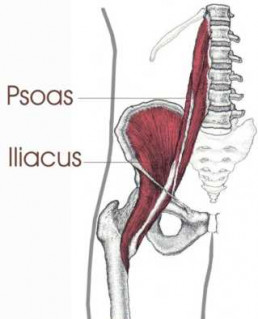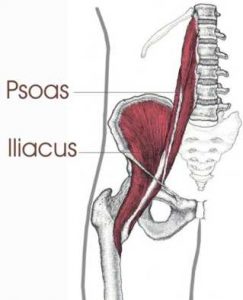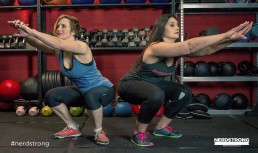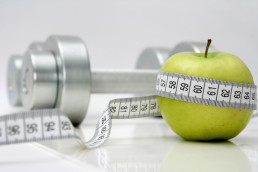Fighting Food Cravings
Cravings are a common hurdle to fitness in a world where unhealthy choices are often the easiest. The leftover box of donuts in the staff room or the candy by the checkout counter are so convenient and appealing. How can we make good choices when our bodies call out for something we know is unhealthy?
DRINK WATER & SLEEP

When we are low on energy or dehydrated, our body reacts by making us crave foods that will give us energy! Usually, we reach for foods high in carbs and sugar. If you are thinking about snacking, drink a glass of water first to see if that's what your body really needs. Make sure that you are getting enough sleep, or if you can't get your 8 hours, try drinking unsweetened tea or black coffee to give you a boost without adding to your sugar intake.
EAT MORE FREQUENTLY
There is a difference between emotional cravings and real hunger. Fend off hunger by spacing out your healthy meals and having planned snacks throughout the day. Be sure to measure servings and keep track of nutritional values. The idea is to eat more often, not to eat more.

EAT MORE PROTEIN
Protein is a great way to fight food cravings, because it keeps you feeling full for longer! Protein also contributes to lean muscle mass, and it actually uses up more calories just to digest it, so it’s a great option when you are working to get fit. Every meal of your day, including snacks, should include protein.
UNDERSTAND YOUR CRAVINGS
Most cravings are caused by emotional factors, like stress or boredom. Do you suddenly want candy before a meeting with your boss? Do you end up snacking while you're watching Netflix at home? Maybe when you think about your ex you binge on ice cream? Once you identify the root of your cravings it is easier to resist them. Try elevating your mood in other ways, like creating an upbeat or relaxing playlist of music to listen to whenever a food craving strikes. The songs provide an emotional release AND won't add regret to your feelings later in the day!
DISTRACT YOURSELF
Food cravings behave like waves: They build, crest, and then disappear. If you can distract yourself for a 10-15 minutes, it's very likely that your craving will subside and you will be able to move on with your day. Distractions that involved moving are especially effective. Try taking a short walk, some simple cleaning, or making a phone call to take your mind off of food.
BE PREPARED

Study your daily routines. If you get cravings every afternoon around 3pm, make sure that you are prepared! Arm yourself with healthy pre-portioned snacks so you don’t overdo it when your cravings inevitably strike. Fiber-rich or nutrient-dense snacks are longer-lasting pick-me-ups than the sugar- and fat-filled treats we tend to yearn for. Make sure to keep track of nutritional values and servings, and make sure that protein is a part of those snacks. Having these smarter snacks on hand will also help you make good choices when cupcakes or donuts unexpectedly show up at the office.
BE HONEST & KEEP TRACK
It's easy to lose track of how much we eat throughout the day. We tell ourselves that the 5 Jelly Beans we grab from the receptionist's candy jar don't count, a drink after work can't have THAT much sugar, or that having a larger portion than the prescribed serving won't really matter, but it adds up. Be honest with yourself about how much you are consuming throughout the day. A few impulsive choices can undo a lot of hard work, but remember...

TOMORROW IS ANOTHER DAY
There are times when enjoying a piece of birthday cake with a friend or sharing ice cream with your kids is worth it! Let yourself indulge sometimes! It helps keep life fun, but be sure to be honest with yourself about how often and how much you are indulging.
I wrote this article for the NerdstrongGym.com blog!
April 21, 2015
Top 5 Moves for Healthy Hips
The hips are one of the most important joints in the human body. Our hips are responsible for supporting our body weight and they are the most important point in our body for maintaining balance and for correcting the alignment of the spine to maintain healthy posture. Hips do a lot!
Unfortunately, most of us aren't very kind to our hips. We spend long hours sitting at desks or on the couch which weakens our hip muscles and starts limiting their mobility. Humans were not made to sit in a chair position for hours on end and most of us don't realize how limited our hip mobility has become until we start trying to get back in shape.
BEFORE YOUR WORKOUT:
1) THE COUCH STRETCH
Do not let the name of this stretch fool you! It is not as comfy as it sounds, but it will do wonders for stretching out your hips and improving mobility. Start with short amounts of time, such as 2 reps of 20 seconds on each leg, then build up as your comfort and flexibility increase.
2) THE HIP OPENER STRETCH
This video has a lot of information! Watch it all! The specific move we love starts at 1:55 and really works wonders to improve mobility.
3) BANDED HIP FLEX
The muscles that flex a joint are called "flexors." This move will help stretch your hip flexors and make prep them for whatever your workout throws at them!
FOR AFTER YOUR WORKOUT:
4) PSOAS MUSCLE RELEASE
The psoas muscle is one of our hip flexors. If we constantly contract the psoas due to stress, tension, or sitting for long periods of time, the muscle eventually begins to shorten leading to a host of painful conditions including low back pain, sacroiliac pain, sciatica, disc problems, scoliosis, hip degeneration, knee pain, and more. This awkward looking move helps release and relax the psoas muscles and can combat chronic lower body pain.
5) ILIACUS RELEASE
This super simple move releases the iliacus muscle which is important for flexing the femur forward. Prolonged sitting with the iliacus in a shortened state, or just the lack of stretching over time, can lead to the iliacus adapting to its shortened position and cause many lower body mobility and pain issues. (It is connected to the psoas, so do moves #4 and #5 together!)
Making time for a few minutes of mobility work before and after your workouts can be a game changer! No matter how strong you become, you will not be able to do most movements correctly without muscle mobility. Make these five moves a part of your regular routine and your hips will be healthy and happy!
I wrote this article for the Nerdstronggym.com blog!
April 8, 2015
Surviving Girl Scout Cookie Season
IT'S FEBRUARY, AND THAT MEANS THAT YOUNG GIRLS ALL OVER AMERICA ARE TRYING TO RUIN YOUR HEALTHY DIET... I MEAN, SELL COOKIES TO RAISE MONEY IN SUPPORT OF THE GIRL SCOUTS OF AMERICA.

Almost all of us get the Girl Scout sales pitch eventually. Whether it is a relative, a friend's kid, or an enthusiastic gaggle of girls selling at the exit of our favorite supermarket, we are faced with the difficult decision to buy Girl Scout cookies, or not. It's hard to say no. After all, it supports a great cause, and who wants to face the disappointment on a little girl's face? Plus, the cookies are delicious! So what can you do to stay healthy in this sugar filled season?
DONATE COOKIES TO OUR TROOPS
This is by far the healthiest option! You support your favorite Girl Scout, but the cookies are sent to the brave men and women serving overseas in the US military. When you purchase cookies from a Girl Scout troop that is participating in the "Gift of Caring" program, you simply mark on the form how many boxes you would like to purchase for the troops. The Girl Scouts of America will coordinate the shipping! It's all the caring with none of the calories! (As an added bonus, you can write the cookies off on your taxes as a charitable donation!)

GIVE COOKIES AS A GIFT
Giving away the cookies as a gift is another great option. It's not as easy as donating to the troops because you have to receive the cookies, then have the strength to give them away again! This strategy works best if you initially order the cookies for specific people, rather than ordering a bunch of boxes and then try to decide who gets them.
KNOW THE COOKIES

If you are going to order cookies for yourself, make good choices. Visit the Cookie Page on the Girl Scouts' website for the nutritional information before you buy!
Best Choice: The shortbread cookies are probably the least bad for you (notice, I don't say good for you!) With a serving size of 4 cookies, you get 120 calories (30 calories per cookie), 4.5 g total fat, 2 g saturated fat, 0 g trans fat, 105 mg sodium, 19 g total carbohydrate, <1 g fiber, 4 g sugars, 1 g protein. Per cookie, the calories are pretty low. One serving also delivers the least amount of total fat and sugar. There are only 10 ingredients in the ingredient list—and sugar appears a mere two times.
Worst Choice: Caramel deLites are probably the worst Girl Scout Cookie for your diet. Just two cookies contain 140 calories (70 calories per cookie), 7 g total fat, 6 g saturated fat, 0 g trans fat, 85 mg sodium, 19 g total carbohydrate, 1 g fiber, 13 g sugars, 1 g protein. Caramel deLites deliver the most saturated fat (one serving is 30 percent of your daily value) and although it’s labeled as containing 0 grams of trans fat, the ingredient list includes partially hydrogenated oil. Caramel deLites also have the most sugar of all the cookies—in fact, sugar is the first ingredient (most of the others list flour first), and is disguised under different names a total of six times on the ingredient list.
Notice: Some cookies have two different names! That's because GSoA uses two different bakers to make their cookies! The cookies may look the same, but they may have different nutritional information. For example, Caramel deLites have 12 grams of sugar per serving, while their twin cookie Samoas only have 10 grams of sugar.
PAY ATTENTION TO PORTIONS
Most Girl Scout Cookies have a serving size of 1-4 cookies. It can be really easy to finish of half a box in one sitting, especially if you aren't paying attention. It's just so easy to grab one more cookie... and then one more. To prevent this, read the portion size when you first get the box of cookies and write the serving size in big letters on the box to help keep you strong. If you really struggle with portion control, it might be best to pre-sort the cookies into sandwich bags with the appropriate amount of cookies in each bag.
STAY STRONG!
You can do this! The short-term gratification of binging on cookies is not worth risking your long-term goals and results. Think of it this way: Living a healthy life now will help insure that you are around to support the Girl Scouts for many more years to come!
Improve Your Squats
 WHAT IS A SQUAT?
WHAT IS A SQUAT?
SQUATS ARE COMPOUND, FULL-BODY EXERCISES THAT WORK YOUR LOWER BODY AND CORE. THEY ARE THE FOUNDATION FOR MANY FITNESS MOVEMENTS, INCLUDING OLYMPIC WEIGHT LIFTING MOVES, AND HELP BUILD MUSCLE STRENGTH, ENDURANCE, AND BONE DENSITY.
Squats have been a part of human movement for as long as we have existed. It is only in more modern times that we have lost the art of squatting in favor of using chairs, which in turn has started to limit our mobility and strength. Although doing a proper squat may seem like a challenge at first, it is actually reclaiming a completely natural movement that our bodies were built to do daily.
HOW DO I SQUAT?
Squat technique is very important to prevent injury and maximize gains. For Air Squats, you should always make sure that you are starting in a strong standing position.
STRONG STANDING POSITION
- FEET - Your feet should be shoulder-width apart at the heels, your toes should be straight or turned out at about a 15 degree angle.
- KNEES - Your knees should be right above your feet and trace out over your toes as you perform your squat.
- HIPS/BUTT - This should start right above your knees and feet. This is the first part of your body to move.
- CHEST - Think Superman or Wonder Woman! Keep your chest up with shoulders back.
- ARMS - Start off straight at your sides, then move out in front of you to act as a counterbalance as you squat down, and move back down to your sides as you return to a standing position.
- HEAD - Should be in a neutral position, in line with the natural curve of your spine. Don't look up or down at your feet.
SQUAT MOVEMENT
Check out this video from Craic Media:
Notice the order of the movements:
1) He starts at a strong standing position (see the check list above!!) so that his body is ready to work.
2) His weight stays on his heels throughout the whole movement! The heels are the foundation with the outside edge of his feet and his big toe being fixed to the ground for extra balance support.
3) THE HIPS AND BUTT ARE THE FIRST THINGS THAT MOVE! It's almost like he is about to sit on an invisible chair. His hips and butts move back and down and the knees only bend as a natural progression once his butt can't get any farther by itself. (This is super obvious in this video around :16)
4) The knees should always be over the feet. They trace out directly over the toes as you go into the squat, both on the way down and as you return to the standing position. One of the most common flaws is allowing the knees to collapse in as you are moving. The image below shows incorrect knee form (left) and correct knee form (right).

5) His butt drops down below the height of his knees, aka drop below being parallel with the floor. Be careful though, you don't want to "bottom out" by having your butt hit the back of your ankles since this can cause back strain. A general guideline is to have the crease of your hips (where your legs attach to your torso, aka where your tighty whities end) drop below the level of your knee crease when you are at the bottom of your squat.
6) To return to your starting position, he thrusts his hips up and forward as he straightens his knees. Be sure to keep your knees over your feet (see #3) and to keep your weight on your heels.
7) He completely returns to the strong standing position with legs and hips straight, chest up, butt flexed, and ready to go again.
WHY IS IT SO HARD?
Squats are especially challenging for those of us with careers that require a lot of sitting. Our lack of flexibility and strength may not allow us to do squats properly. If you find yourself coming up on your toes, are struggling to keep your knees over your feet, can't drop below parallel, or are struggling to keep your chest up, talk to your coach. They can give you a modified version of a squat to do until you build up your strength and mobility! Don't give up!!
SQUAT MYTHS
SQUATS ARE BAD FOR YOU KNEES.
Doing squats INCORRECTLY is bad for your knees, which is why proper technique and training is so important. Correct squats distribute the work to your hips, core, and all parts of the legs, but incorrect squats often increase the stress and pressure by putting most of the work on the knees. This is why FORM is the most important part of working out! If something hurts, talk to your coach.
SQUATS MAKE YOUR HIPS WIDER.
Hip width is mostly genetic. People are born with wide hips or they aren't, and no amount of squats will change the fundamental bone structure of a person. Squats will make the hips and butt that you were born with look FABULOUS, but won't do anything more than tone what nature already gave you.
SQUATS MAKE YOUR BUTT HUGE.
Again, squats only tighten and improve on what nature gave you. If you have an ample butt, squats will make it toned and fit when combined with a healthy diet. If you have a gluteus minimus (small butt), squats will give your butt more curve and shape, but they aren't going to turn into Kim Kardashian.
POWER TO THE SQUATS!!
Squats help with flexibility, stability, strength, and they help improve all the problem areas that so many of us are trying to tone. They are the foundation of many more advanced movements, so take your time in perfecting your technique and reap the benefits in the future!
I wrote this article for the NerdstrongGym.com blog!
February 4, 2015
The First Steps to Getting Fit
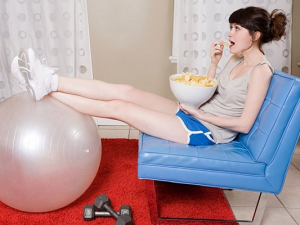 Like most Americans, I've spent a good portion of my adult life playing fitness musical chairs. Weight Watchers, 24 Hour Fitness, yoga, counting calories, workout videos, spinning classes, Barre class, online newsletters, Curves... you name it and I've tried it. Sometimes, I was lucky and got limited results, but none of it stuck or made a meaningful difference in my overall health. This is the trap that we fall into with fad diets, free trials, unrealistic expectations, and short-term goals. So how do we really change our lives and make healthy habits the new norm?
Like most Americans, I've spent a good portion of my adult life playing fitness musical chairs. Weight Watchers, 24 Hour Fitness, yoga, counting calories, workout videos, spinning classes, Barre class, online newsletters, Curves... you name it and I've tried it. Sometimes, I was lucky and got limited results, but none of it stuck or made a meaningful difference in my overall health. This is the trap that we fall into with fad diets, free trials, unrealistic expectations, and short-term goals. So how do we really change our lives and make healthy habits the new norm?
Answer: Be realistic. Brutally realistic.
Step 1: Be Realistic about Your Plan
Most people aren't going to be able to sustain an immediate total overhaul of their lifestyle long-term. The passion of our New Year's Resolutions or fear of the bridesmaid's dress fades, and we go back to  our normal routine. Unless you have superhuman motivation or willpower, you have to be more realistic with your fitness plan and your ability to stick with it. Start off by committing yourself to one lifestyle change and make it something measurable so that you can hold yourself accountable. Remember: It's better to make one permanent change than five changes that you can't sustain.
our normal routine. Unless you have superhuman motivation or willpower, you have to be more realistic with your fitness plan and your ability to stick with it. Start off by committing yourself to one lifestyle change and make it something measurable so that you can hold yourself accountable. Remember: It's better to make one permanent change than five changes that you can't sustain.
For me, it was deciding that I was going to find a way to be physically active at least twice a week. I'll be honest, it was difficult at first. My busy schedule didn't leave much room for anything new, but I could see my body was wasting away from sitting at a desk all day. Movement had to be my first priority.
Step 2: Be Realistic about Your Implementation
This step can also be called "Be Brutally Honest about Yourself."
So I decided that I was going to be active twice a week. Great! Now I had to figure out how I was going to make that happen. That started with really looking at what had caused me to fail so many times before. Why hadn't I been able to stick with anything? I warn you, this isn't always a flattering experience, but being TOTALLY honest about yourself allows you to make a plan that you can actually stick with.
On reflection, I found that I am a cheapskate, unwilling to drive very far, competitive, unable to change my work schedule, need an authority figure (coach/teacher) to please, and am motivated by the opinions of my peers. Super confidence building, right?
But seriously, each one of these things contributed to my previous failures. I'd join a yoga studio when they had a half-priced deal and then quit when the price changed to $200 a month. I'd try "do it yourself" programs (Weight Watchers online, workout videos, and online newsletters) or mega gyms (24 Hour Fitness) because they cost less, but I was just a credit card number to them and there was nobody to coach me, cheer me on, or hold 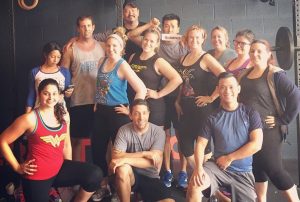 me accountable. I'd sign up for some trendy new fitness class only to find myself unable to make it to their limited class schedule (the spin class), be discouraged because of an inconvenient drive (Barre class), or find that I wasn't being challenged (Curves). After making my new plan, I went looking for a gym that worked with all my faults - er, personality quirks - and eventually found one that was the perfect fit for me. I really feel that is why, nine months later, I have successfully gone from going to the gym twice a week to going four to six times a week and am LOVING IT. (Shameless plug: NerdstrongGym.com)
me accountable. I'd sign up for some trendy new fitness class only to find myself unable to make it to their limited class schedule (the spin class), be discouraged because of an inconvenient drive (Barre class), or find that I wasn't being challenged (Curves). After making my new plan, I went looking for a gym that worked with all my faults - er, personality quirks - and eventually found one that was the perfect fit for me. I really feel that is why, nine months later, I have successfully gone from going to the gym twice a week to going four to six times a week and am LOVING IT. (Shameless plug: NerdstrongGym.com)
Your implementation may not be a gym. Maybe it's joining a softball team, or signing up for dance classes. Maybe it's prepping your weekly lunches on Sunday so that you don't have to think about it before work or starting a salad club at your office. Maybe it's finding a workout buddy or getting a personal trainer. The possibilities are endless! Be creative, but be true to yourself. Don't be afraid to try something, evaluate, and then switch to something else if it isn't working for you.
Step 3: Be Realistic about Your Expectations
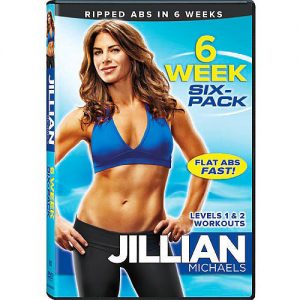
The media has poisoned us into thinking that impossible results are the norm. We see infomercials with insane before and after pictures, celebrity exercise videos that promise to completely change us in a few weeks, and magazine ads for diets and supplements that will melt away our woes for a credit card number. DON'T BE FOOLED! These things are designed to make us feel inadequate and like fitness failures because they are trying to sell us crap. The fitness market is a multibillion dollar industry that DOESN'T WANT US TO SUCCEED, because once we are in shape we will stop buying what they sell. The worst part is that their tactics work. Our self-confidence plummets and we start looking for the next miracle elixir that will fix us NOW.
Real fitness improvement takes time and dedication. We are talking months or years, not days or a few weeks. Keep your expectations realistic! Stay patient, and keep at it! Do not give up!
![]() My trick for staying motivated has been keeping track of my progress in multiple ways. Recording my improvements at the gym (weight lifted, number of reps, speed) has been my #1 measure, followed by body measurements and clothing size/fit. Our bodies change and fluctuate based on tons of factors. Multiple measures mean that I constantly see progress in some aspect of my fitness, even if some measure plateaus or regresses. This strategy really works for me and has helped keep me motivated through my holiday "setbacks"! Just make sure it is something quantifiable so that your progress isn't subjective. Running farther without walking, dancing for more songs, lowering your cholesterol level, waist and arm measurements - there are so many things you can track! Be sure to keep a written record of whatever your measures are so that you can really see your progress!
My trick for staying motivated has been keeping track of my progress in multiple ways. Recording my improvements at the gym (weight lifted, number of reps, speed) has been my #1 measure, followed by body measurements and clothing size/fit. Our bodies change and fluctuate based on tons of factors. Multiple measures mean that I constantly see progress in some aspect of my fitness, even if some measure plateaus or regresses. This strategy really works for me and has helped keep me motivated through my holiday "setbacks"! Just make sure it is something quantifiable so that your progress isn't subjective. Running farther without walking, dancing for more songs, lowering your cholesterol level, waist and arm measurements - there are so many things you can track! Be sure to keep a written record of whatever your measures are so that you can really see your progress!
Please note: Weight is an unreliable measure of progress. I am working to cut off my relationship with the scale because it doesn't truly measure fitness or health. You can get stronger or lose inches and still weigh the same or more! I suggest that you don't use weight as one of your measures!!
Knowing what path to take is the most important part of any journey. Fitness is no exception. The latest fad or what worked for your best friend may not be your path. Don't be afraid to try different things until you find what works for you. Eventually, my twice-a-week exercise schedule became as routine as going to work, and I was ready to create Kimi's Fitness Plan 2.0. Once your first change becomes the norm, you can focus on taking another step. You can do it!
Have a fitness plan that really worked for you? Help your fellow geeks by sharing your experience in the comments below!
